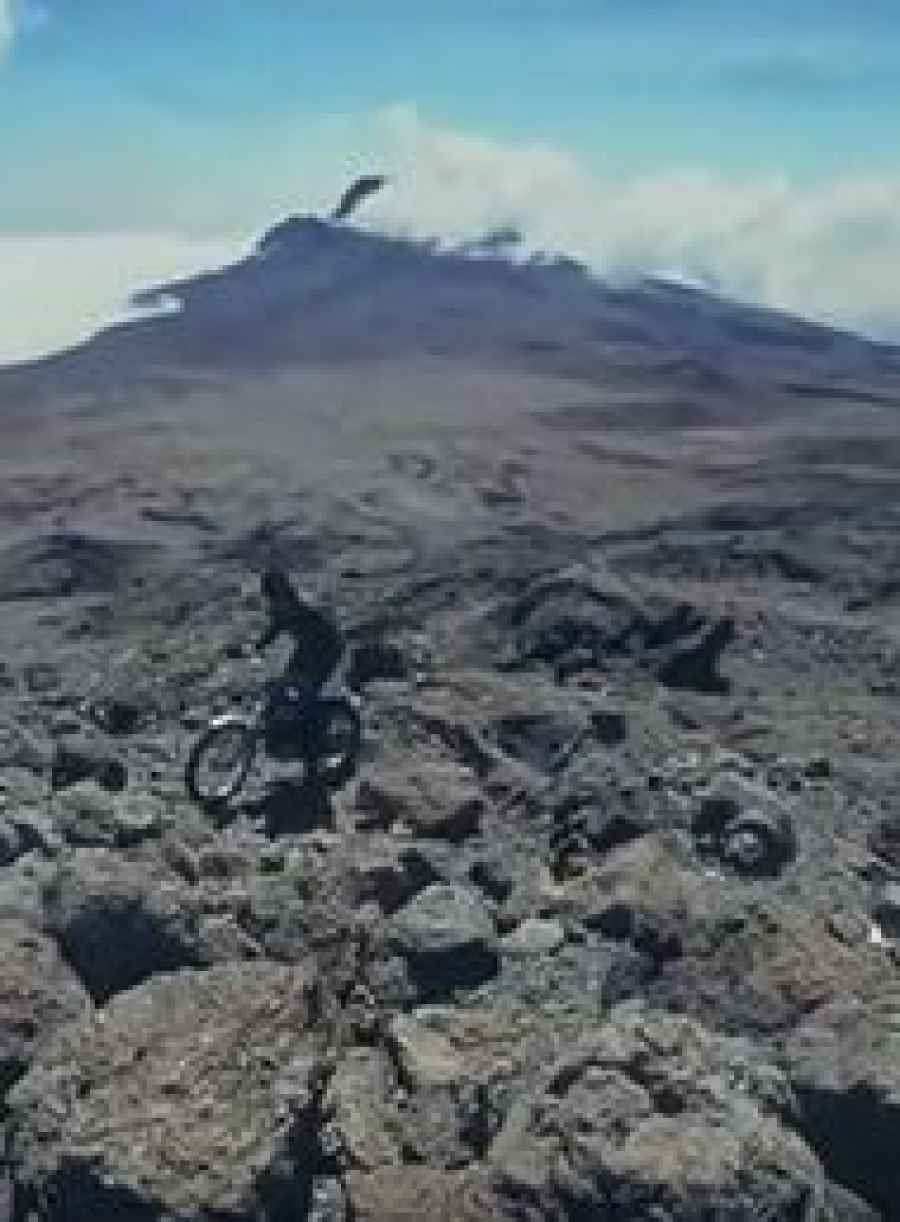How to Reach the Summit of Mount Kilimanjaro by Motorcycle? An Altitude Record in Africa
The Moto Igualada – Kilimanjaro Expedition, also simply known as Moto Igualada – Kilimanjaro, was a motorized expedition carried out by eight Catalans in 1974. During this expedition, they reached the summit of Mount Kilimanjaro aboard a Bultaco Sherpa T 250cc motorcycle, thereby matching the world record for altitude on a motorcycle. At an elevation of 5.895m (19,341ft) above sea level, it’s one of the highest roads in Africa.

The expedition, organized by the Moto Club Igualada, consisted of amateur mountaineers and trial enthusiasts from Igualada: Pep Bou, Juli Bernaus, Josep Maria Casas, Santiago Godó, Josep Maria Lladó, Jaume Llansana, Joan Mollà, and Jaume Travesset. A few years later, Godó, Lladó, and Llansana were part of the Moto Igualada-Aconcagua expedition, which set a new world record by reaching 6,800 meters on Aconcagua in January 1977.
It was on October 26, 1974, that the members of the expedition reached Uhuru Peak (on the Kibo), the highest point of Mount Kilimanjaro. Although the record at that time was set at 6,010 meters, the actual height of Uhuru Peak is 5,895 meters, which is the figure that appears on the certificate of achievement (19,340 feet). The confusion might have arisen because the height of Kilimanjaro has been measured several times throughout history, with varying results at each measurement.
Background
The first motorized expedition to reach the summit of Mount Kilimanjaro was led by New Zealander Billy d, who, along with Chris Sharp and Doug Parry, reached Uhuru Peak on March 7, 1973, aboard a ČZ 250cc motocross bike. Billy d thus set the world record for altitude on a motorcycle, correctly fixing it at 19,340 feet (5,895 meters). Following this expedition, in December 1973, Frenchmen Christian Lacombe and Pierre Barret reached Gilman’s Point (18,640 feet, 5,681 meters) on a Yamaha TY250 trial bike.
Additionally, the Moto Himalaya Expedition, undertaken by six Barcelonans, reached 5,156 meters in the Himalayas on November 16, 1973, specifically at the Imja Khola glacier.
Initial Idea
While earlier expeditions were underway, Jaume Travesset and Santi Godó from Igualada had been planning their own expedition for some time. In early 1973, the expedition was finalized, and after two years of preparations, they decided to depart in July 1974 with two Bultaco Sherpa T 250 motorcycles (one driven by Josep Maria Lladó, with license plate B-1007-AM, and the other B-1008-AM). They also brought an off-road vehicle for support.
The plan was to drive from Igualada to Algeciras by road, then embark to Tangier and cross Africa from north to south, finally reaching the Kilimanjaro National Park. Once in Maasai territory, they needed to adjust the motorcycles to handle the altitude, snow, and ice in order to reach the summit of Uhuru Peak. Afterward, the same motorcycles had to be driven back to Catalonia, crossing the Algerian Sahara. The route was expected to cover approximately 20,000 kilometers in four months, with the goal of doing the entire journey on the motorcycles.
Outbound Route
Once on the African continent, the expedition passed through the following countries on its way to Kilimanjaro:
- Morocco
- Spanish Sahara, visiting the Bucraa phosphate mines
- Mauritania, passing through the Atar route, a small strip entering back into the Spanish Sahara and crossing the Rosso river
- Senegal, passing through Dakar, Gorée island, and Tambacounda
- Mali, passing through Bamako
- Ivory Coast, passing through Sakassou and Abidjan
- Ghana
- Togo, passing through Lomé
- Dahomey
- Nigeria, passing through Lagos and Biafra, entering the Igbo area, which was then full of guerrillas
- Cameroon
- Central African Republic
- Belgian Congo (then called Zaire) until reaching the Serengeti
- Rwanda
- Tanzania
In Tanzania, they stayed at the Marangu Hotel, from where the Marangu Route to the Kilimanjaro summit begins. This was the same route used by previous expeditions. After obtaining the necessary permits (following some negotiations with the park’s director, who initially only allowed them to use the more difficult Machame Route instead of Marangu), on October 21 they began their ascent, aiming to reach the second refuge at 3,700 meters.
Ascent, Day by Day
On Tuesday, October 22, they spent the night at Horombo Hut and in the morning completed a half-journey to Kibo Hut to acclimate.
On Wednesday, October 23, in the afternoon, they arrived at the final refuge at 4,800 meters. Travesset and Lladó left their motorcycles a bit higher.
On Thursday, October 24, the real difficulties began, especially when crossing volcanic rock scree without assistance. The whole team reached Gilman’s Point at 5,820 meters. However, the motorcycles were left at 5,100 meters (near Meyer Cave) and 5,500 meters.
On Friday, October 25, the ascent continued. Given the extreme difficulty for the motorcycles, they decided to continue with only one Sherpa T 250 motorcycle (B-1007-AM), which Josep Maria Lladó took to the summit.
On Saturday, October 26, after passing slippery scree and large rocks in the final 500 meters, at 3:00 PM, they reached Gilman’s Point (5,681 meters, the point where Lacombe and Barret had reached). By 5:00 PM, they finally reached Uhuru Peak at 5,895 meters. The previous expeditions had used ropes to carry the motorcycle up certain sections, while the Igualada team completed the ascent without any external help, relying only on the motorcycle’s power.
Return Route
After leaving Kenya and enduring a forced stop in Ethiopia for over a month (due to unrest), the five remaining members of the expedition finally arrived home on January 13, 1975.